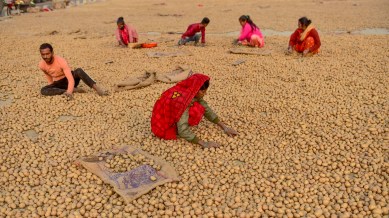Stay updated with the latest - Click here to follow us on Instagram
Nano DAP gains ground in Punjab amid shortage of traditional fertiliser
IFFCO has been doing several trials to boost the confidence among farmers regarding its usage and there are several farmers who have used it under IFFCO’ recommendation are waiting for the results.

Amid a significant shortage of traditional Diammonium Phosphate (DAP) fertiliser in Punjab, the usage of Nano DAP has more than doubled this year, highlighting its potential as an alternative solution for farmers.
According to data, farmers in Punjab have used 3.25 lakh bottles of Nano DAP from April 2024 to till date largely in wheat season, compared to 1.5 lakh bottles in the entire financial year in 2023-24. While Indian Farmers Fertiliser Cooperative (IFFCO) has been actively promoting Nano DAP with the aim of exceeding one million bottles in annual usage, adoption remains gradual as farmers continue to rely on traditional fertiliser methods.
monthly limit of free stories.
with an Express account.
Traditional farming practices involve using one or one-and-a-half bags of DAP, which is in the form of granular, per acre per crop. In comparison, Nano DAP in liquid form, require only a 500 ml bottle per acre, offering significant cost savings and environmental benefits.
DAP is quite crucial for wheat and this year there was 30% shortage of DAP in the beginning of wheat sowing the ideal time of which was from November 1 to 15. However, sowing is still continuing and several farmers across the state could not get the required amount of DAP this year.
Punjab requires nearly 5.50 lakh tonne of DAP for the Rabi season from October to April, during which wheat, potatoes and various other vegetables (grown in three cycles) are cultivated. Wheat alone needs around 4.35 lakh tonnes of DAP.
Harmail Singh Sidhu, IFFCO’s state marketing manager, highlighted the cost-effectiveness of Nano fertilisers. He said that One bottle of 500 ML costing Rs 600 of Nano DAP, which is much lower than the Rs 1,350 required for a 50 kg bag of conventional DAP, is sufficient for one acre. He said that till date 3.25 lakh bottles of DAP have been consumed in Punjab against 1.5 lakh last year but IFFCO aims to increase it’s usage over one million bottles annually.
He added that nano DAP can also be used to treat seeds prior to sowing (5 ml per kg of seeds) for better results.
“A 200 ml to 230 ml Nano DAP is required for seed treatment if farmers are putting 40 or 45 kg wheat seed per acre.
The remaining 50% should be used as a foliar spray after the crop’s leaves emerge,” he said, adding that by cutting down the use of granular fertiliser by 50% the soil and the environment would be benefited.
Nano fertilisers are absorbed by plants with 90-95% efficiency, compared to the significant nutrient loss of up to 60% in traditional methods where fertilisers are sprinkled on soil. This high absorption rate not only reduces environmental pollution but also preserves soil health, added Sidhu. Experts said that Nano fertilisers are indigenous and cost-effective, requiring no subsidies, unlike imported DAP, which place a heavy financial burden on the country. The usage aligns with India’s goals of reducing dependency on imports and promoting sustainable farming practices.
Farmers like Gurpreet Singh from Bhagthala Kalan village in Faridkot district who had witnessed the benefits firsthand for his maize crop earlier this year, said that this time because of the non-availability of the traditional DAP he had used nano DAP for sowing wheat crop and hoping to get the good results.
However, building confidence among farmers remains a challenge. Traditional fertilisers are deeply entrenched in farming practices, and Nano DAP, despite its advantages, is still viewed with skepticism.
IFFCO has been doing several trials to boost the confidence among farmers regarding its usage and there are several farmers who have used it under IFFCO’ recommendation are waiting for the results.
With rising awareness of its cost-efficiency, environmental benefits, and compatibility with drone technology, Nano DAP usage is expected to grow in Punjab. While the current surge is partly driven by the shortage of traditional DAP, experts believe its long-term adoption will depend on continued farmer education and demonstration of its effectiveness.